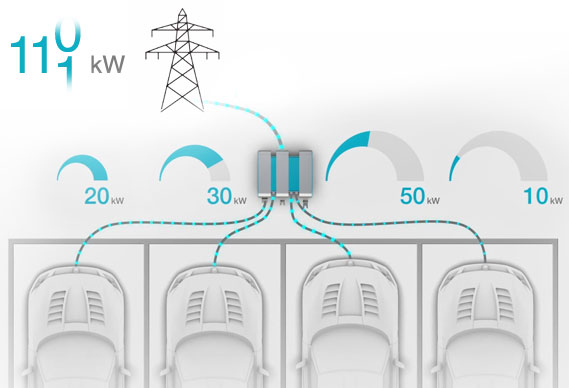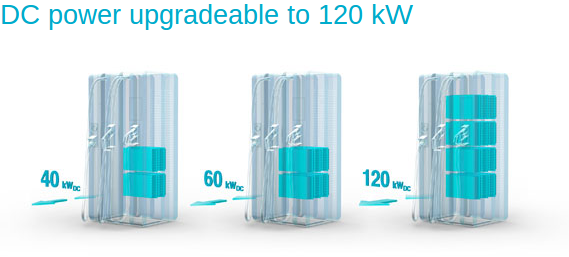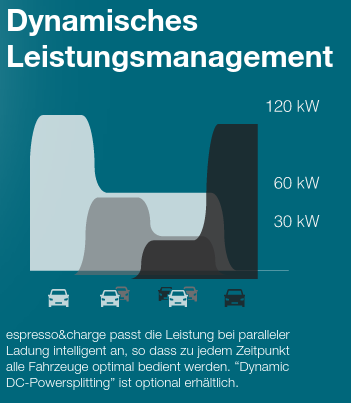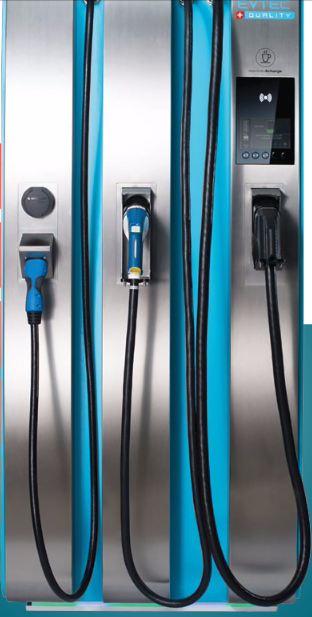Longtailpipe.com: The debate over electric car fast charging systems has been going on for years, and the only sign of a settlement is that some of the automakers areinvesting in dual-protocol fast charging infrastructure. While it’s a great interim solution, as a practical matter the existing dual-protocol DCFC stations can only charge one car at a time. But now there’s a new DCFC station which supports a maximum total 120 kiloWatts charging rate, which can be split up to charge four cars simultaneously.
The maker is Swiss company EVTEC AG. Their“expresso & charge” electric car fast charging station supports up to 120 kiloWatts DC and 60 kiloWatts AC, it can interface with cars using any of the fast charging standards from Europe, North America and Japan. (NOTE: “standards” based charging systems, not proprietary systems like Tesla’s)
The DC power available from a given station is adjusted by adding modules, each capable of 10 kiloWatt DC current. By default it supports 60 kW DC and 60 kW AC, and to support more power simply requires stacking in more modules.
According to a press report from Europe, the EVTEC expresso & charge station was recently unveiled in Geneva Switzerland, along with a Kia Soul EV. Why a Soul EV? Well, because that’s the first electric car supporting 100 kiloWatt charging via CHAdeMO, and this station supports a 100 kW CHAdeMO charging rate. The Kia Soul EV was shown in Europe, in September 2014, with a different 100 kW CHAdeMO station made by a Korean company.
The power management feature is the most interesting, so let’s start there.

This graphic shows a hypothetical dynamic distribution between cars plugged into one of their stations. This “Dynamic DC Power Splitting” is an optional feature, but is interesting nonetheless.
There are other dual-port DC Fast Charging stations on the market, but to my knowledge this is the only one which dynamically shares power between multiple ports.

This graphic tries to show how, by adding more power modules, the DC power can be increased.
 This is a Swiss company, hence the German language. But the graphic is pretty clearly demonstrating that as cars come and go the power level to each car is adjusted dynamically. Again, it’s an optional feature (“ist optional”).
This is a Swiss company, hence the German language. But the graphic is pretty clearly demonstrating that as cars come and go the power level to each car is adjusted dynamically. Again, it’s an optional feature (“ist optional”).
Let’s turn now to the charging connectors.

This range of supported charging connectors supports AC Level 3 Fast Charging, the Combo Charging System through both American and European plugs, and the CHAdeMO standard through its plug. I’ve posted more details on fast charging systems over on greentransportation.info.
To my knowledge the AC Level 3 charging is only used by the Renault ZOE (43 kiloWatts 3-phase AC) and the Smart Electric Drive (European version supports 24 kiloWatts 3-phase AC).
The Combo Charging System uses a different connector whether it’s in Europe or North America, but it’s the same pins in either case. This chart shows both varieties since both the AC Level 3 and the Combo Charging System use the Mennekes type 2 connector in Europe.
What’s left out of this picture is the Tesla Supercharger. That’s a proprietary system despitethe pseudo-open-source-patents announcement they made last summer. Tesla simply changed the licensing fee for their patents to $0, they did not “open source” the technology behind the patents. But let’s not get side-tracked …
The SPEC sheet has some interesting details to go over.
On the CHAdeMO side, they’re certified for version 0.9 and are “compatible” with version 1.0.1 of the spec. On the Combo Charging System side, they’ve done compatibility testing with GM, BMW and VW. Charging via 3-phase AC is done through the IEC 62196 connector that’s also used for the European version of Combo Charging System. The “Socket” option shown above is used with the 22 kiloWatt implementation on the Smart ED.
DC charging can run at up to 120 kiloWatts through either the CHAdeMO or CCS connectors. The DC output voltage can range from 170 volts to 500 volts. While that’s great for the range of electric cars on the market, this has caused trouble for Zero Motorcycles because their pack voltage is much lower.
In short – this is a flexible DC fast charging station design. The upgrade-ability is similar to what Tesla does with the Supercharger system. In Tesla’s case they adjust maximum power output by adding charging modules as needed.
The bottom line for electric car owners is that the automakers can have their little standards war so long as the charging infrastructure supports both CHAdeMO and CCS. We’ll still be able to charge our cars while they fight their battle.
The primary advantage Tesla’s fast charging has over the rest of us is a higher maximum charging rate. That is, Tesla supports up to 120 kiloWatts at Supercharger ports while typical CHAdeMO or CCS infrastructure maxes out at 50 kiloWatts or less. But charging stations like this one could give the rest of us parity with our Tesla-owning cousins.
UPDATE: With a hat/tip to Tony Williams (QuickChargePower), the CHAdeMO Association is planning a display at the Mobilitec 2015 conference. According to the press release their booth will include several charging station makers including:
a new high power (up to 180kW) fast charger that would be suitable for very busy locations (e.x. motorway rest area and private fleet charging) where it can charge simultaneously up to 4 EVs. There will also be light mobile chargers as well as wall box chargers for garages.
The first part of this statement sure sounds like the EVTEC charging station just described, and sure enough EVTEC is one of the listed companies. This quote discusses a likely usage scenario along busy highway corridors. Indeed, the Expresso & Charge station is essentially an open standards compliant version of the Supercharger.
A CHAdeMO “light mobile charger” would also be very welcome, as would be a unit sized appropriately to use in a garage.
